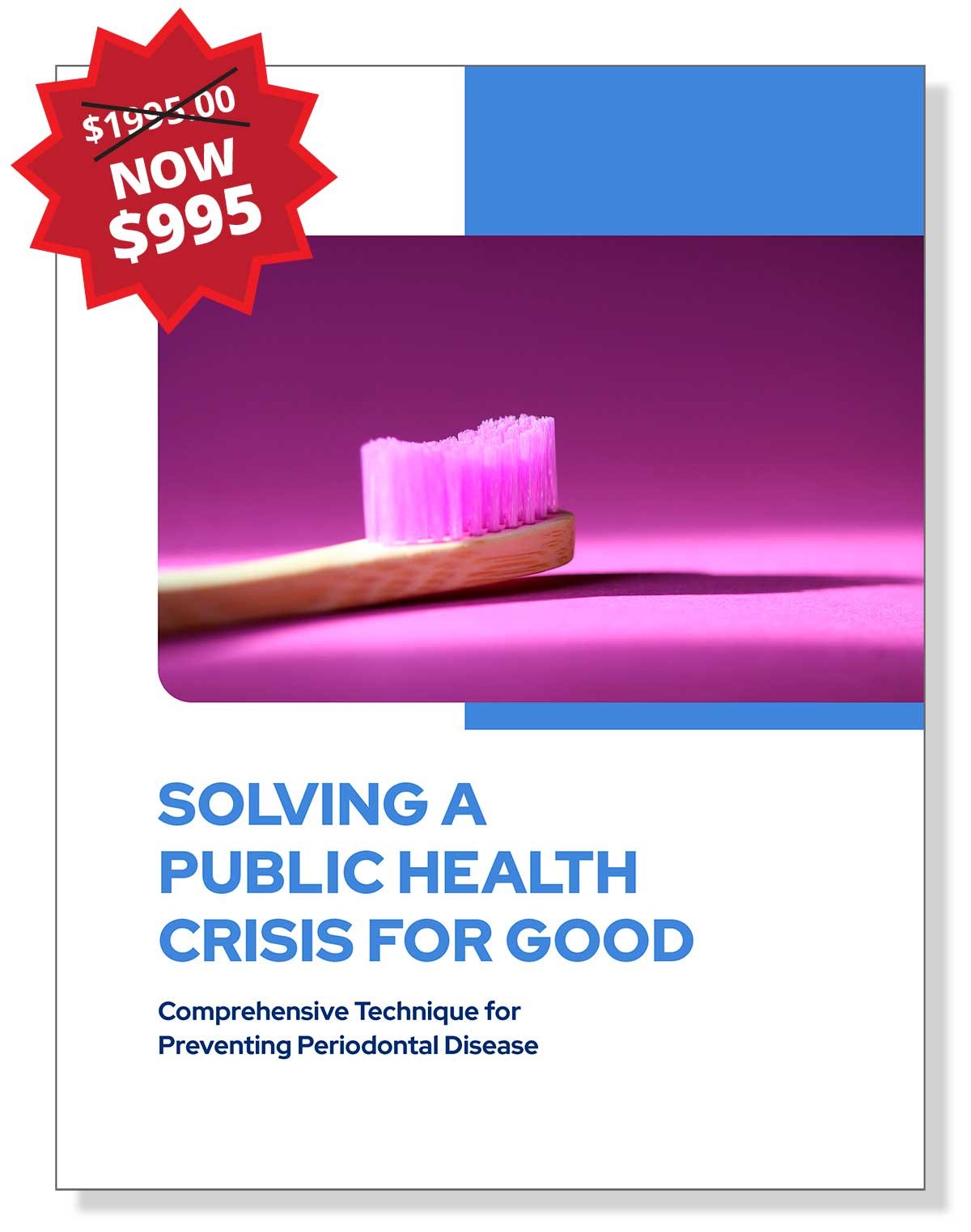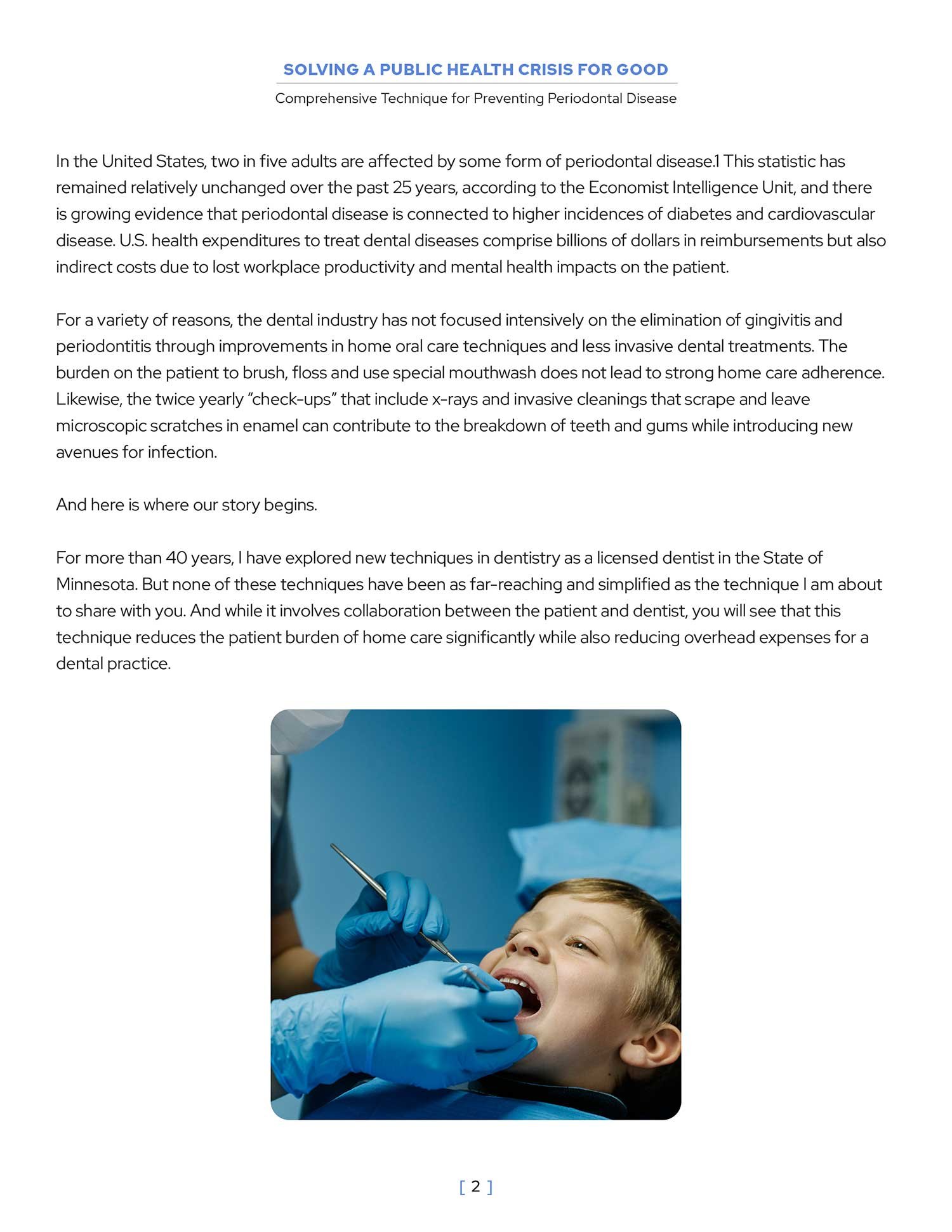Dr. Doering's Periodontal White Paper
Not convinced? Read two excerpts [left and below].
The dental industry trains hygienists to pick and scrape teeth to remove plaque and calculus. These instruments can put microscopic scratches in the surface of tooth enamel right at the gum level. Traditional dental tools also have the potential to inflame or injure healthy gums, even if hygienists have years of experience. It is no surprise that some patients have high anxiety prior to their dental visits.
Patients who adhere to my at-home care technique have healthy pink gums and the benefit of preventing plaque, calculus and caries. In addition, my cleaning technique is non-invasive while reinforcing antibacterial and disinfectant properties.
The downside (or upside?) for the industry with this technique is less need for dental hygienists. Rather than needing up to four dental hygienists per dentist as allowed by most states, my technique (if teachable to traditionally trained hygienists) would cut cleaning time per patient substantially. This is the benefit of reduced staff overhead expenses that I alluded to earlier in my introduction.
Overall Benefits and Conclusions
After using this technique with 100 patients for the past two years, I have seen these consistent benefits for my patients, and more:
Reversed and eliminated periodontal disease (no pockets, bleeding or inflammation)
Reduced oral bacteria count
Miniscule calculus
Zero plaque accumulation
No caries/cavities
Reduced pain
Healthy, pink gums
Retained natural teeth
No need for antibiotics
My patients, ranging in age from 20s to 80s, are happier with their dental hygiene and health, with less anxiety and longer retention of their natural teeth, even into their 90s. They also experience low anxiety, if any, when visiting the dentist. They also report several hours of clean mouth sensation with this technique.
*If you purchase the whitepaper now, receive an exclusive invitation for free training with Dr. Doering.
Not convinced? Read two excerpts [left and below].
The dental industry trains hygienists to pick and scrape teeth to remove plaque and calculus. These instruments can put microscopic scratches in the surface of tooth enamel right at the gum level. Traditional dental tools also have the potential to inflame or injure healthy gums, even if hygienists have years of experience. It is no surprise that some patients have high anxiety prior to their dental visits.
Patients who adhere to my at-home care technique have healthy pink gums and the benefit of preventing plaque, calculus and caries. In addition, my cleaning technique is non-invasive while reinforcing antibacterial and disinfectant properties.
The downside (or upside?) for the industry with this technique is less need for dental hygienists. Rather than needing up to four dental hygienists per dentist as allowed by most states, my technique (if teachable to traditionally trained hygienists) would cut cleaning time per patient substantially. This is the benefit of reduced staff overhead expenses that I alluded to earlier in my introduction.
Overall Benefits and Conclusions
After using this technique with 100 patients for the past two years, I have seen these consistent benefits for my patients, and more:
Reversed and eliminated periodontal disease (no pockets, bleeding or inflammation)
Reduced oral bacteria count
Miniscule calculus
Zero plaque accumulation
No caries/cavities
Reduced pain
Healthy, pink gums
Retained natural teeth
No need for antibiotics
My patients, ranging in age from 20s to 80s, are happier with their dental hygiene and health, with less anxiety and longer retention of their natural teeth, even into their 90s. They also experience low anxiety, if any, when visiting the dentist. They also report several hours of clean mouth sensation with this technique.
*If you purchase the whitepaper now, receive an exclusive invitation for free training with Dr. Doering.
Not convinced? Read two excerpts [left and below].
The dental industry trains hygienists to pick and scrape teeth to remove plaque and calculus. These instruments can put microscopic scratches in the surface of tooth enamel right at the gum level. Traditional dental tools also have the potential to inflame or injure healthy gums, even if hygienists have years of experience. It is no surprise that some patients have high anxiety prior to their dental visits.
Patients who adhere to my at-home care technique have healthy pink gums and the benefit of preventing plaque, calculus and caries. In addition, my cleaning technique is non-invasive while reinforcing antibacterial and disinfectant properties.
The downside (or upside?) for the industry with this technique is less need for dental hygienists. Rather than needing up to four dental hygienists per dentist as allowed by most states, my technique (if teachable to traditionally trained hygienists) would cut cleaning time per patient substantially. This is the benefit of reduced staff overhead expenses that I alluded to earlier in my introduction.
Overall Benefits and Conclusions
After using this technique with 100 patients for the past two years, I have seen these consistent benefits for my patients, and more:
Reversed and eliminated periodontal disease (no pockets, bleeding or inflammation)
Reduced oral bacteria count
Miniscule calculus
Zero plaque accumulation
No caries/cavities
Reduced pain
Healthy, pink gums
Retained natural teeth
No need for antibiotics
My patients, ranging in age from 20s to 80s, are happier with their dental hygiene and health, with less anxiety and longer retention of their natural teeth, even into their 90s. They also experience low anxiety, if any, when visiting the dentist. They also report several hours of clean mouth sensation with this technique.
*If you purchase the whitepaper now, receive an exclusive invitation for free training with Dr. Doering.

